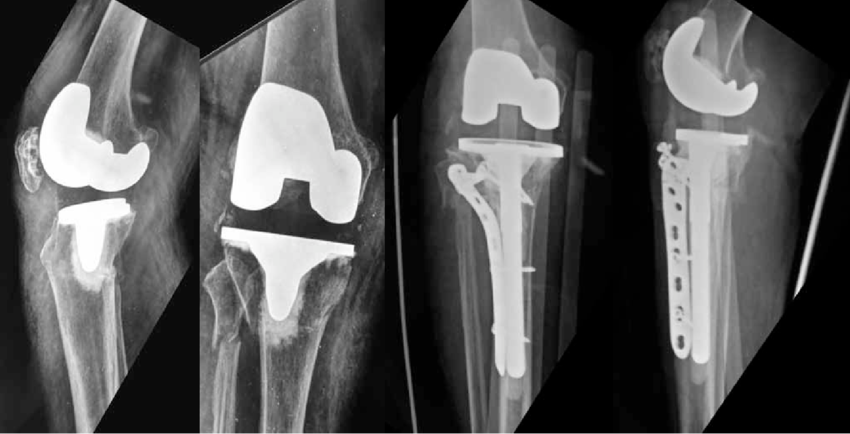Fracture (Periprosthetic) following Knee Replacement - Will I be able to Walk Again?
A fracture in the bone around a knee replacement may occur after the knee was replaced. Oftentimes, such fractures occur years after the knee replacement. A fracture near a knee replacement is also called a periprosthetic fracture. This may involve the femur, the tibia, and the patella. This happens to most patients that have other predisposing medical conditions.
Classification of Periprosthetic Knee Fracture
Fracture after knee replacement is often classified based on the location of the fracture;
1. Femur periprosthetic fracture (occurring above the knee point)
2. Tibia periprosthetic fracture (occurring below the knee point)
3. Patella periprosthetic fractures (occurring at knee cap)
It is worthy of note that the treatment of fracture after knee replacement is dependent on these locations.
Risk Factors for Developing Fracture after Knee Replacement
If you have the following conditions or belong to the following group, it makes it likely to develop a peri-prosthetic fracture after getting a knee replacement:
1. Elderly
2. Osteoporosis
3. Rheumatoid arthritis
4. Twisting movement
5. Prolonged use of corticosteroids
6. Overweight/Obesity
7. Poliomyelitis
8. Trauma or fall at home
9. Vigorous physiotherapy
Some factors are induced by a surgical procedure that can put you at risk of having a periprosthetic fracture. These include screw holes, notching, and implant misalignment.
Signs and Symptoms
You are likely to experience all or some of the following if you have this type of fracture:
1. Pain
2. Swelling
3. Bruising
4. Inability to bear weight on the affected leg
5. Deformity of the leg from the exterior.
What can be done to avoid fracture?
1. Please follow your doctor's instructions
2. Customize your home to prevent falls before choosing a TKR
3. Eat a healthy diet to improve bone quality
4. Regular recommended exercise after surgery. Avoid contact sports.
5. If the activity hurt you, consult your doctor or physiotherapist
6. Periodic examination by your doctor
What Happens following a Periprosthetic Knee Fracture?
Following a fracture after knee replacement, the repair is the next on the line. The treatment largely depends on the type of fracture, location of the fracture, the overall health of the patient, quality of bone left, and other assessments too.
Femur Periprosthetic Fracture
The treatment options include non-operative and operative methods. Non-operative involves the use of cast materials to hold a stable prosthetic fracture and allow it to heal. The operative method includes using a nail or plate to properly align and hold the fracture. Revision of the prosthesis, and Distal femoral replacement (commonly for the elderly patient). Your doctor will decide which method is best for you.
Tibial Periprosthetic Fracture
Like femur periprosthetic fracture, tibia periprosthetic fracture is on the tibia (shin bone). This fracture type can be treated by both non-operative and operative methods. Casting is done for the stable form, while surgical fixation is done for both stable prostheses with an unstable fracture. Taking out the existing prosthesis and placing a revision prosthesis is reserved for the loose tibial component.
Patellar Prosthetic Fracture
The treatment options here also includes both non-operative and surgical method. Similar to Tibia and Femur Periprosthetic Fracture, casting or bracing works for un-displaced fractures with stable implants. Operative fixation, Taking out a small piece of the patella, tendon repair, patellar resection arthroplasty with fixation, and excising the whole patella is done in other cases.
Each treatment modality aims to restore knee function, stability, mobility, and alignment.
What are the Complications of Fracture after Knee Replacement?
The under-listed are significant complications that could occur following fracture after knee replacement:
1. Secondary fracture
2. Immobility
3. Wound infection
4. Non-union (fracture fails to unite)
5. Malunion (fracture unites but not in the desired alignment)
6. Poor functional outcome
7. Muscle atrophy
8. Bed sores from lying in a spot
9. Mental retardation in elderly following multiple surgeries
10. Pneumonia, UTI.
All information on this website (https://www.doctor-pal.com) is published in good faith and for general information purposes only. Dr. Indranil Pal does not guarantee the completeness, reliability, or accuracy of this information. Actions based on the information found on this website are entirely at your own risk. Doctor Pal shall not be liable for any loss and/or damage associated with the use of our website. Contact your doctor who can advise you on your health and illness.










